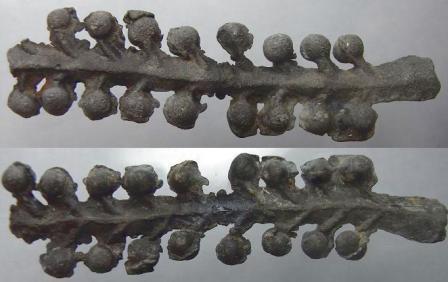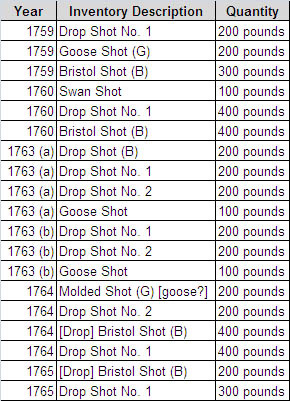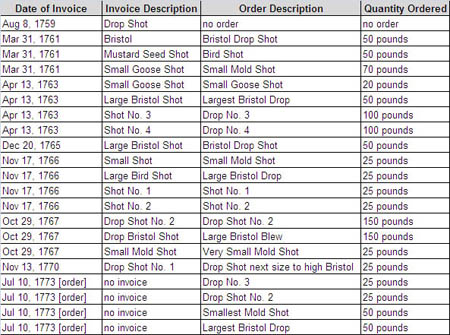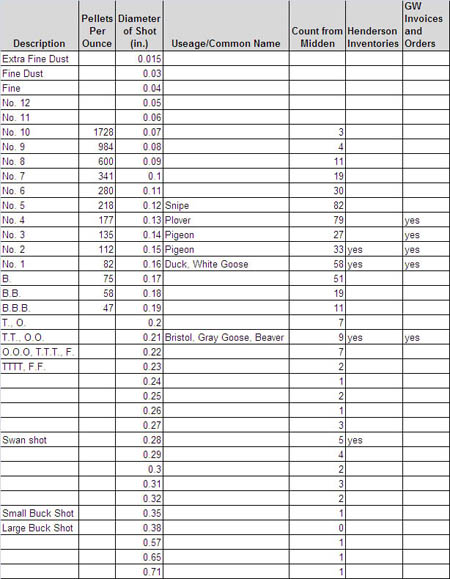-
Friends, our 2nd Amendment rights are always under attack and the NRA has been a constant for decades in helping fight that fight.
We have partnered with the NRA to offer you a discount on membership and Muzzleloading Forum gets a small percentage too of each membership, so you are supporting both the NRA and us.
Use this link to sign up please; https://membership.nra.org/recruiters/join/XR045103
You are using an out of date browser. It may not display this or other websites correctly.
You should upgrade or use an alternative browser.
You should upgrade or use an alternative browser.
Small Shot For Smoothbores.
- Thread starter Le Loup
- Start date

Help Support Muzzleloading Forum:
This site may earn a commission from merchant affiliate
links, including eBay, Amazon, and others.
How big are those pigs?
Le Loup
32 Cal.
Read the article tenngun.How big are those pigs?
Keith.
Hello Keith,
There has been a long standing argument over what "swan Shot" actually was. Some think it was a shot size smaller than 24 caliber but larger than BB (.177)
Others think it was "Rupert's" shot or something similar, crude dropped shot that was ovoid or had tails.
My own theory is that both are correct. That it was a dropped ovoid shaped shot with a size larger than BB.
When you look at this picture, it's easy to see the parallels.
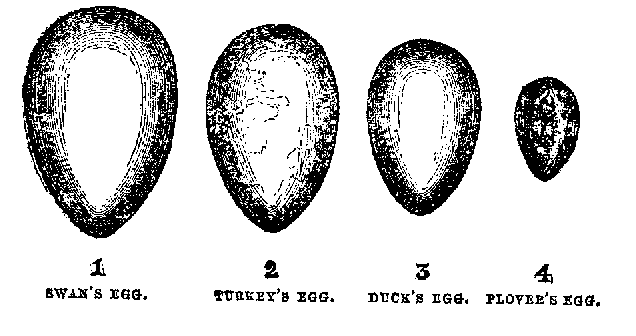
The shot you posted would be considered by many to be "buckshot" being of 31 caliber.
Cast shot is not ovoid like shot dropped without a tall tower., it is round. and is usually larger than 24 caliber.
I'm not saying that larger shot won't work, I suspect it was a necessity given the size and distance of a swan. They are usually not easy to get close to. At least the ones I tried to get near weren't.
This is just my opinion. Make of it what you will.
Le Loup
32 Cal.
Hello Keith,
There has been a long standing argument over what "swan Shot" actually was. Some think it was a shot size smaller than 24 caliber but larger than BB (.177)
Others think it was "Rupert's" shot or something similar, crude dropped shot that was ovoid or had tails.
My own theory is that both are correct. That it was a dropped ovoid shaped shot with a size larger than BB.
When you look at this picture, it's easy to see the parallels.

The shot you posted would be considered by many to be "buckshot" being of 31 caliber.
Cast shot is not ovoid like shot dropped without a tall tower., it is round. and is usually larger than 24 caliber.
I'm not saying that larger shot won't work, I suspect it was a necessity given the size and distance of a swan. They are usually not easy to get close to. At least the ones I tried to get near weren't.
This is just my opinion. Make of it what you will.
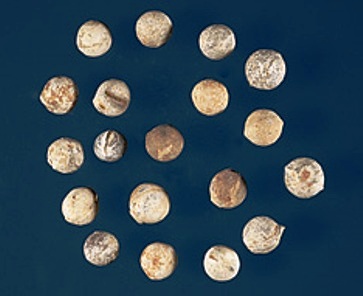
This image was labeled Swan shot from Fort Dobbs.
Swanshot I believe was also known as goose shot, referring to the shot used for the bird rather than the shape of the shot.
Keith.
I can't argue with that. But, I do wonder if the etymology changed over the years or if it had multiple definitions.
I also wonder when it was labeled? Was it a period label or a modern archeological one?
The latter could be prone to misidentification.
I also wonder when it was labeled? Was it a period label or a modern archeological one?
The latter could be prone to misidentification.
Le Loup
32 Cal.
I totally agree C6, we can only do what we can with what we have. Much the same as items found at Revolutionary war sites, but they could well date back to the French & Indian war period or earlier.I can't argue with that. But, I do wonder if the etymology changed over the years or if it had multiple definitions.
I also wonder when it was labeled? Was it a period label or a modern archeological one?
The latter could be prone to misidentification.
The research goes on
Keith.
I missed the link to your blog when I first looked through. I do think ‘swan’ refers to size, like buck, snipe and beaver shot, not shape. I do think after years went by the explanation changed. Just as claymore means something now, different then how it was used in the old days. I remember a New Yorker telling me that ‘Wal street’ was named becaus large buildings made the road feel like one was between walls. Or a prospector reinactor at sutters mill told me flash in the pan referred to silica reflecting light like gold, he never shot a flinter.
Cow boys were once cattle rustlers, crackers once story tellers and braggarts. Words change then the explanation changes to keep up.
Cow boys were once cattle rustlers, crackers once story tellers and braggarts. Words change then the explanation changes to keep up.
Capt. Jas.
58 Cal.
- Joined
- Aug 19, 2005
- Messages
- 3,048
- Reaction score
- 1,351
Swan, goose, etc were specific shot sizes in the 18th century. They were cast. There are even written references to gang molds for swan shot being available in America for purchase.
The Bedford Co VA ranging militia preferred goose shot to single bullets for fighting Indians.
The Bedford Co VA ranging militia preferred goose shot to single bullets for fighting Indians.
It is my understanding swan shot was largely cast by the user utilizing a soap stone mold? Has anyone recreated such a mold? I've tried casting shot with a small hole drilled through the center of a heated spoon. Molten lead was poured onto the spoon and it would fall into a dish of water. Small scale shot tower! Worked well but lacking on efficiency to say the least and ended up ovoid in shape. Certainly in a pinch it's crude nature was overshadowed by it's usefulness.
Unable to get Keiths link to load, assuming it covers the use of a mold judging by the image.
Unable to get Keiths link to load, assuming it covers the use of a mold judging by the image.
- Joined
- May 6, 2014
- Messages
- 17,373
- Reaction score
- 16,263
The following information comes from “Colonial Frontier Guns,” by T.F. Hamilton
Before 1665 shot (as distinguished from swan and buckshot, which have always been cast in gang molds) was made by the laborious method of cutting sheet lead into cubes and then tumbling them in a barrel to more or less round off the corners. Kurz (1937:322)
From the 1733 documents translated from French and for supplying Louisiana, here are the sizes of small shot mentioned they were contracting for and in decreasing order of size:
Bustard (aka Bastard) Shot
Duck Shot
Wild Pigeon or Royal Shot
Half Royal Shot
What this tells us is that instead of using numbered sizes of shot as we do today, they described small shot sizes by what game the small shot would be used on AND they were specific sizes of shot.
Gus
Before 1665 shot (as distinguished from swan and buckshot, which have always been cast in gang molds) was made by the laborious method of cutting sheet lead into cubes and then tumbling them in a barrel to more or less round off the corners. Kurz (1937:322)
From the 1733 documents translated from French and for supplying Louisiana, here are the sizes of small shot mentioned they were contracting for and in decreasing order of size:
Bustard (aka Bastard) Shot
Duck Shot
Wild Pigeon or Royal Shot
Half Royal Shot
What this tells us is that instead of using numbered sizes of shot as we do today, they described small shot sizes by what game the small shot would be used on AND they were specific sizes of shot.
Gus
Le Loup
32 Cal.
Any chance of a link to those references Capt ?Swan, goose, etc were specific shot sizes in the 18th century. They were cast. There are even written references to gang molds for swan shot being available in America for purchase.
The Bedford Co VA ranging militia preferred goose shot to single bullets for fighting Indians.
Keith.
Le Loup
32 Cal.
It is an article on small shot Cd & the link to my blog is still good, I just tried it.It is my understanding swan shot was largely cast by the user utilizing a soap stone mold? Has anyone recreated such a mold? I've tried casting shot with a small hole drilled through the center of a heated spoon. Molten lead was poured onto the spoon and it would fall into a dish of water. Small scale shot tower! Worked well but lacking on efficiency to say the least and ended up ovoid in shape. Certainly in a pinch it's crude nature was overshadowed by it's usefulness.
Unable to get Keiths link to load, assuming it covers the use of a mold judging by the image.
Keith.
Le Loup
32 Cal.
Le Loup
32 Cal.
Capt. Jas.
58 Cal.
- Joined
- Aug 19, 2005
- Messages
- 3,048
- Reaction score
- 1,351
For the molds that was in the PA Gazette and the quote about the goose shot preferred to bullets was found in the Executive Journals of the Council of Colonial Virginia.
Any chance of a link to those references Capt ?
Keith.
Thanks Keith, my phone is outdated by todays standards and I'm not an owner of a computer. Unfortunately things on my end act up!
Le Loup
32 Cal.
I tried to post the whole article here, but this forum will not allow more than 1000 characters!Thanks Keith, my phone is outdated by todays standards and I'm not an owner of a computer. Unfortunately things on my end act up!
Keith.
Similar threads
- Replies
- 0
- Views
- 399
- Replies
- 3
- Views
- 278




